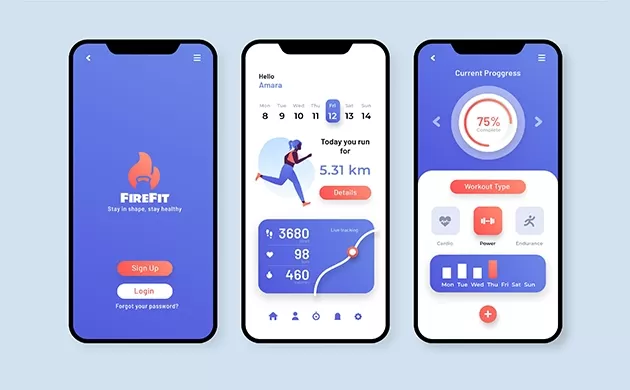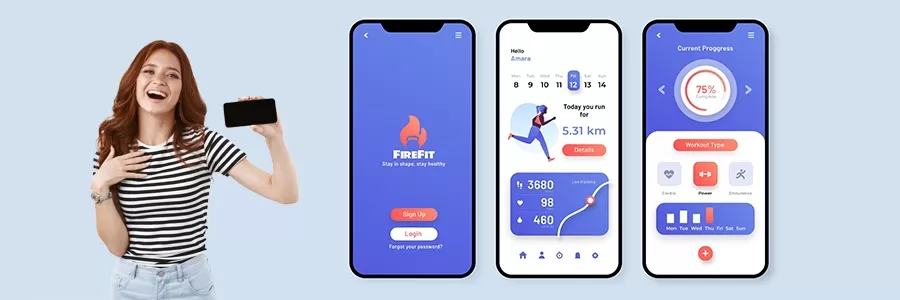Here are 12 tricks that you can employ to boost the number of downloads and improve engagement with your mobile application and Mobile App Marketing Strategies.
1. Choose an attractive icon for your app
Visual clues attract people. So, your app’s icon must have more than one idea to follow. The app’s icon will be the first item prospective customers will see in your app’s store. Make sure that you make sure you create a visually appealing icon.
The icon you pick must be identifiable and memorable. It must communicate the brand as well as the features of the application. Also, your logo must convey to users a clear impression of what they’ll experience upon downloading and launching your application.
2. Prioritize the optimization of app stores
Many marketers are aware of SEO or search engine optimization (SEO); however, app creators that want to get more downloads should keep up with the optimization of apps (ASO) rate.
Both are the same. However, ASO is specifically designed to help increase the visibility of your app in the marketplace.
Relevance of keywords important way to improve your app’s visibility is to improve the keywords you include in your app’s title and description. Utilize Google’s AdWords Keyword Tool or keyword tracking tools such as Sensor Tower or App Radar to determine the most relevant keywords for your search.
Categories: If you upload your application to the App Store, select the right category carefully. Choose one that is appropriate to your app but is not overly broad.
Applications Downloads: The number of users that download the app can affect your overall rank.
Positive Reviews: When you receive more positive reviews about your application, and it is more highly rated, this will, in turn, increase the number of downloads. The app should remind users of reviews at specific times could assist in driving these reviews.
Location: Think about the areas where your intended audience is and modify your description of the app to reflect the areas. That could involve changing your description of your app store to a different language or choosing images that are pertinent and pertinent to the area.
App use: The rating of your app is affected by the number of people who use your app and the proportion of users who download and remove the app. So ensure you’re communicating with your app’s users regularly.
Social proof: following factors that affect the popularity of your app’s presence on social media could influence its popularity. Please create a new social media profile for your app, or integrate it into your corporate posts.
3. Start a blog or website
A successful mobile application marketing involves more than simply developing a great app – you must also ensure that it’s easy to locate. You can increase the app’s reach and reach prospective customers by connecting to a site or blog.
Websites are often the primary site people visit for answers to their issues. If they’re seeking help with scheduling, shopping and productivity and entertainment. You’re missing out on many of your customers when you’re not listed in search engines.
You can create an SEO-standard website that expands the information you include in your app store listing. Consider incorporating blogs on your site to demonstrate different applications for your app. It will also assist in attracting the attention of customers seeking topics related to your product.
4. Create a demo video
It is not easy to grasp all the advantages of your app simply by reading the description or looking through some pictures. Another way to show off your app and boost downloads is to make your intro video.
Create a brief, 30-second video explaining what you are, how to do, and what your application is about. Focus on the usability and well-known features of your app. After you’ve created your video, make sure to share it on your website and other social media channels. Please don’t ignore it to include it in your list of apps in the store.
5. Use attribution and analytics tools
You can maximize the efficacy of your marketing by measuring and distributing downloads so you can study how to invest your money inefficient channels and make the needed adjustments to channels that do not work.
Mobile app allocation tools let you connect your app’s settings to any advertisement, target audience, or platform to maximize your marketing strategies.
6. Use mobile communication channels
Another method you could utilize is communicating with your current customers directly through any mobile device. It doesn’t matter if it’s in-app messaging and push notifications for mobile. These channels let you connect with your customers at the appropriate time and the right moment with targeted messages.
You could consider directing users to a new feature that you’ve just released or enticing them to follow some tips within an area of your app that’s hard to use. You could also invite existing users to assist in promoting your app through push notifications and in-app messaging to motivate them to share with friends on social media or refer to their friends or post feedback on the store for apps. These are excellent methods to keep interacting with users, promote your app, and give it the needed viral potential.
7. Utilize the app’s in-app tracking features
The information you gather from your existing customers can assist you in improving your marketing strategies and products to boost downloads and increase participation with your application.
By using in-app tracking, it is possible to understand your user’s behavior and preferences better. Are they removing your applications at a specific date? How frequently does an intermediate user log in, and for what time? Are there any features that seem to receive more attention than other features? Do you have any usability issues that you’d like to fix?
You can use a range of tracking tools in your app that starts by installing an entire development software suite (SDK) that allows you to connect with your app’s data. Some sites offer features like custom tagging and behavioral tracking that provide the data required to enhance the user experience and improve install of Apps.
Mobile app allocation tools let you connect your app’s settings to any advertisement, target audience, or platform to maximize your marketing strategies.
6. Use mobile communication channels
Another method you could utilize is communicating with your current customers directly through any mobile device. It doesn’t matter if it’s in-app messaging and push notifications for mobile. These channels let you connect with your customers at the appropriate time and the right moment with targeted messages.
You could consider directing users to a new feature that you’ve just released or enticing them to follow some tips within an area of your app that’s hard to use. You could also invite existing users to assist in promoting your app through push notifications and in-app messaging to motivate them to share with friends on social media or refer to their friends or post feedback on the store for apps. These are excellent methods to keep interacting with users, promote your app, and give it the needed viral potential.
7. Utilize the app’s in-app tracking features
The information you gather from your existing customers can assist you in improving your marketing strategies and products to boost downloads and increase participation with your application.
By using in-app tracking, it is possible to understand your user’s behavior and preferences better. Are they removing your applications at a specific date? How frequently does an intermediate user log in, and for what time? Are there any features that seem to receive more attention than other features? Do you have any usability issues that you’d like to fix?
You can use a range of tracking tools in your app that starts by installing an entire development software suite (SDK) that allows you to connect with your app’s data. Some sites offer features like custom tagging and behavioral tracking that provide the data required to enhance the user experience and improve install of Apps.
8. Create a link to your mobile app
Another method you can use to boost the number of downloads you receive dramatically is by incorporating deep links into your app that allow users to access the mobile experience for the users. Businesses like Branch and Kochava provide this service that allows users to switch between apps and the web more smoothly. It makes the mobile application more accessible and visible to users regardless of the platform they come across you on. It can also help you monitor the data behind your app, which lets you know how users interact with your application.
9. Advertorial on social media
There are more than 3.5 billion users of social media around the world, which is why it’s crucial to advertise your application on at least one of these networks. Research shows that over 70% of companies use social media to promote their apps for mobile devices. Where do you begin? The foremost action is to find your customers. For instance, Facebook and Instagram are excellent for attracting users interested in comparable products or offerings like yours.
It is possible to make hashtagged social media posts to create buzz before launch, increase brand awareness, or advertise new and enhanced features.
Utilize a mixture of sponsored stories and promotional posts targeted at mobile news feeds on Facebook.
Consider a look at influencer marketing, particularly through platforms like Instagram or Snapchat.
Create contests to encourage users to download your application.
Encourage user-generated content to demonstrate the importance of your application.
One of the benefits of having a dedicated website for your application is that you can utilize Re-targeting to display ads to people who have visited your site but aren’t yet committed to downloading.
Retargeted advertisements are 70 percent additionally likely to convert. These types of ads are 10 times higher rates of click-through as compared to display ads.
11. Encourage testimonials and reviews
Once potential users have discovered your application, they could require convincing to convince them that your app is trustworthy and worthy enough to be downloaded. Reviews can prove helpful.
Positive user feedback can increase the visibility of your app and boost your app’s ranking. Most buyers trust suggestions from friends and family, including user reviews, more than other forms of advertising. Inviting users to leave reviews with an in-app message or a follow-up email after the user has had an enjoyable experience within your app, such as finishing a task or making purchases.
12. Don’t forget to include email marketing in your plans.
Although there are numerous ways to market digital products and services, email marketing remains the most efficient method digital marketers can use once you’ve built your blog and website specifically for your app, created an embeddable subscription form or used a landing page to gather emails from interested leads.
You can also share articles on your website or related articles to keep engaging your leads until they become converts and then present them appropriately with a sequence of welcoming emails. You can anticipate an impressive conversion rate if you approach marketing via email.
Use a mix of these mobile app marketing strategies to put your brand’s name at the forefront of attention and increase the number of downloads.




Leave a Reply